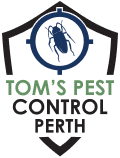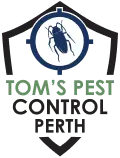Prompt, Affordable Same-Day Pest Control in Perth – From $129.
- Home
- Pest Treatments
- Termite Inspection & Treatment
- Ant Pest Control
- Bed Bug Treatment
- Beetle Pest Control
- Bird Control
- Borer Pest Control
- Cockroach Control
- Flea Control
- Fly Control
- Fox Trapping
- Mite Control
- Mosquito Pest Control
- Moth Control
- Possum Removal
- Silverfish Control
- Spider Control
- Wasp Control
- Rats And Mice Control
- End of Lease Pest Control
- Pest Management Perth
- General Pest Control
- Commercial Pest Control
- Office Pest Control
- Restaurants & Cafes Pest Control
- Hospitality Pest Control
- Education Facilities Pest Control
- Hospital & Aged Care Pest Control
- Pest Control Food Industry
- Factories & Warehouses Pest Control
- Government Buildings Pest Control
- Assets & Facilities Pest Management
- Farming and Agriculture Pest Control
- Strata Pest Control
- Construction Pest Control
- General Pest Control
- Termites
- Pest Info
- Pest Inspection
- Contact
- Home
- Pest Treatments
- Termite Inspection & Treatment
- Ant Pest Control
- Bed Bug Treatment
- Beetle Pest Control
- Bird Control
- Borer Pest Control
- Cockroach Control
- Flea Control
- Fly Control
- Fox Trapping
- Mite Control
- Mosquito Pest Control
- Moth Control
- Possum Removal
- Silverfish Control
- Spider Control
- Wasp Control
- Rats And Mice Control
- End of Lease Pest Control
- Pest Management Perth
- General Pest Control
- Commercial Pest Control
- Office Pest Control
- Restaurants & Cafes Pest Control
- Hospitality Pest Control
- Education Facilities Pest Control
- Hospital & Aged Care Pest Control
- Pest Control Food Industry
- Factories & Warehouses Pest Control
- Government Buildings Pest Control
- Assets & Facilities Pest Management
- Farming and Agriculture Pest Control
- Strata Pest Control
- Construction Pest Control
- General Pest Control
- Termites
- Pest Info
- Pest Inspection
- Contact
White Tail Spider
(08) 6202 7096
Get A Free Quote Now!
Get A Free Quote Now!
White Tailed Spider
About White Tailed Spiders
White tailed spiders get their name from the white tips on their tails and are typically grey or brown. They live indoors and outdoors and feed on other spiders, including black house spiders. Bites from white-tailed spiders can cause pain, swelling, and itching but are generally not considered dangerous to humans. However, it is essential to correctly identify the spider and seek medical attention if you are bitten. For effective Spider control perth, it’s important to address infestations promptly to ensure a safe environment.
Male white tailed spiders are typically tiny, with a body length of about 12mm. The female grows up to 18mm, and both have a leg span of up to 28mm (diameter). They have a distinctive white tip on the end of their abdomen, are also greyish or brownish, and have a mottled appearance.
White- tailed spiders are commonly found in Australia and are known to reside in outdoor areas, such as gardens, and indoor environments, such as homes and buildings. They typically hide in dark, moist, and sheltered places during the day and come out at night to hunt for other spiders and insects. They can often be found in clothing and bedding as they crawl into these areas to escape the light.
White Tailed Spiders – Dangerous or Not?
White tailed spiders are venomous, but their bite is not considered lethal to humans. However, bites from these spiders have been known to cause mild to moderate symptoms, including local pain, swelling, and redness at the bite site. More severe symptoms, such as nausea, headache, and muscle pain, have been reported in some cases, but these are relatively rare. Nevertheless, if a white tailed spider bites you, you should seek medical attention, especially if you have trouble breathing or a rapid heartbeat.
White Tailed Spider Bite
White tailed spiders are not aggressive and unlikely to bite unless provoked or threatened. They usually bite only in self-defence, for example, when squished or trapped. To minimise the risk of being bitten by a white-tailed spider, it is essential to be cautious when handling clothing, bedding, and other items that may have spiders hiding in them. Regularly checking and removing webs and spiders from your home can also help reduce the risk of being bitten.
Reacting to a White Tailed Spider Bite
If a white tailed spider bites you, the following first-aid measures can help reduce symptoms and prevent infection:
- Clean the bite site: Wash the area with soap and water to remove bacteria or venom.
- Apply a cold compress: Place a cold pack or a cloth filled with ice on the bite site to help reduce swelling and pain.
- Take pain medication: Over-the-counter pain relievers can help reduce pain and inflammation.
- Seek medical attention: If you have trouble breathing, rapid heartbeat, or severe pain, seek medical attention immediately. In these cases, the bite may have caused a more severe reaction and medical treatment may be necessary.
It’s important to remember that everyone’s reactions to spider bites can be different, and it is always best to seek medical advice if you are unsure about the severity of your symptoms.
Avoiding A White Tailed Spider Bite
To reduce the risk of being bitten by a white- tailed spider, regularly clean and vacuum your home to reduce the presence of insects, a food source for white- tailed spiders. Store clothing and bedding properly in drawers or cabinets and shake out items before using them to ensure no spiders are hiding inside. Moreover, be careful when handling things such as boxes, bags, or clothing stored in dark, damp areas, as these are familiar hiding places for white- tailed spiders.
Contact Us Today
We are the experts when it comes to spider removal. Our professional pest control technicians have the knowledge and experience to identify the presence of white tailed spiders and use safe and effective methods to remove them.
At Tom’s Pest Control, we believe in eradicating all types of pests from your property through effective pest control treatment. This is why we thoroughly inspect your homes and offices to identify all possible hiding places for white-tailed spiders and treat these areas to prevent future infestations.
Call us now to learn more about eradicating spiders from your property completely.
Frequently Asked Questions
What Do White Tailed Spiders Eat?
White tailed spiders are predators and feed on other spiders and insects, including web-building spiders such as orb-weavers and daddy long legs. They have a unique hunting style and use their long legs to search for prey in dark, sheltered places, such as behind curtains, bedding, and clothing. They are opportunistic hunters and feed on whatever spiders or insects they encounter.
Are these Spiders Dangerous?
White tailed spiders have mild venom, which may cause symptoms like skin irritation, redness, and mild burning sensation or pain. Even though these spiders are not considered dangerous, it is advisable to seek medical help if you get bitten by them.
Do White Tailed Spiders Build Webs?
White tailed spiders do not spin webs and do not use webs to catch their prey. Instead, they hunt spiders and actively search for other spiders and insects to feed on.
 (08) 6202 7096
(08) 6202 7096


